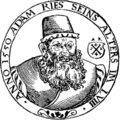Template:Selected anniversaries/March 30: Difference between revisions
No edit summary |
No edit summary |
||
| Line 21: | Line 21: | ||
||1857 – Léon Charles Thévenin, French engineer (d. 1926) no pic | ||1857 – Léon Charles Thévenin, French engineer (d. 1926) no pic | ||
File:Antoine Augustin Cournot.jpg|link=Antoine Augustin Cournot (nonfiction)|1862: Mathematician, philosopher, and crime-fighter [[Antoine Augustin Cournot (nonfiction)|Antoine Augustin Cournot]] uses the ideas of functions and probability to locate and apprehend [[math criminals]]. | |||
||Auguste Bravais (d. 30 March 1863) was a French physicist known for his work in crystallography, the conception of Bravais lattices, and the formulation of Bravais law. Pic. | ||Auguste Bravais (d. 30 March 1863) was a French physicist known for his work in crystallography, the conception of Bravais lattices, and the formulation of Bravais law. Pic. | ||
Revision as of 17:37, 28 March 2018
1599: Mathematician Adam Ries dies. He wrote textbooks for practical mathematics, promoting the advantages of Arabic/Indian numerals over Roman numerals.
1811: Chemist and academic Robert Bunsen born. He will investigate emission spectra of heated elements, and discover caesium (in 1860) and rubidium (in 1861) with the physicist Gustav Kirchhoff.
1862: Mathematician, philosopher, and crime-fighter Antoine Augustin Cournot uses the ideas of functions and probability to locate and apprehend math criminals.
1886: Mathematician, philosopher, and logician Stanisław Leśniewski born. He will posit three nested formal systems, to which he will give the Greek-derived names of protothetic, ontology, and mereology.
1892: Mathematician and academic Stefan Banach born. He will be one of the founders of modern functional analysis.
2015: Asclepius Myrmidon discovers unregistered halting problem, predicts new class of crimes against mathematical constants.





